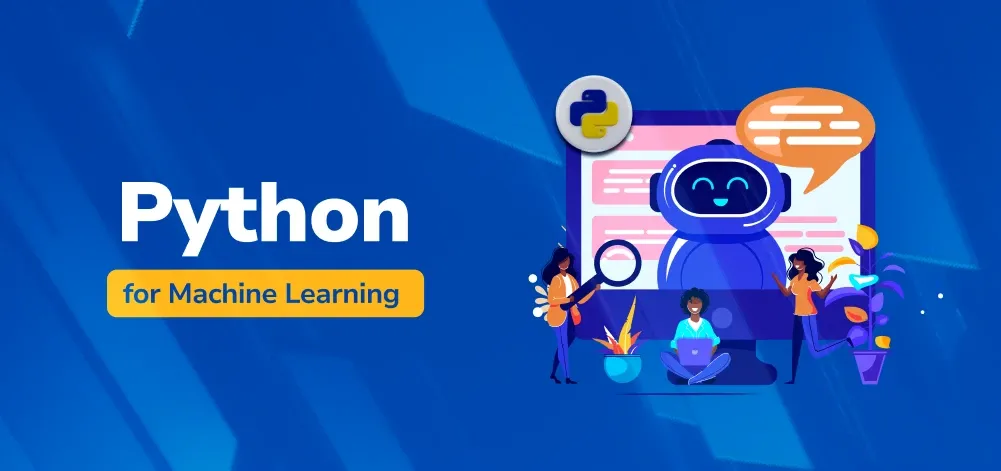In today’s digital age, machine learning (ML) has become the driving force behind innovation in almost every field from healthcare and finance to e-commerce and entertainment. Whether it’s Netflix recommending your favorite show or a bank detecting fraudulent transactions, machine learning makes it possible. Among all programming languages, Python stands as the top choice for building, training, and deploying machine learning models due to its simplicity, flexibility, and powerful ecosystem.
Table of Contents
What is Machine Learning?
Machine learning is a subset of artificial intelligence (AI) that allows computers to learn from data without being explicitly programmed. Instead of writing hard-coded rules, we provide the machine with data and algorithms so it can detect patterns, make predictions, and improve over time.
For example, in spam detection, traditional programming would require manually listing all spam keywords. With ML, the system analyzes thousands of emails, learns what spam looks like, and automatically identifies new spam messages in the future.
Why Python is Best for Machine Learning
Python dominates the ML world for several key reasons:
- Simplicity and Readability: Python’s clear syntax makes it easy to understand complex algorithms.
- Extensive Libraries: Python provides specialized ML libraries like
scikit-learn,TensorFlow, andPyTorch. - Integration Power: It integrates seamlessly with web apps, data pipelines, and APIs.
- Community Support: Millions of developers, tutorials, and open-source projects make learning and troubleshooting easier.
- Cross-Platform Compatibility: You can run Python on Windows, macOS, Linux, and cloud platforms like AWS or Google Cloud.
Because of these advantages, Python has become the universal language of data science and AI.
Essential Python Libraries for Machine Learning
To build ML models efficiently, Python developers rely on a rich set of open-source tools:
- NumPy: Handles mathematical operations and arrays efficiently.
- pandas: Great for data cleaning, preprocessing, and manipulation.
- Matplotlib / Seaborn: Used for visualizing trends and model performance.
- scikit-learn: The most popular library for traditional machine learning — including regression, classification, and clustering.
- TensorFlow / PyTorch: Frameworks for deep learning and neural networks.
- XGBoost / LightGBM: Libraries optimized for high-performance gradient boosting.
The Machine Learning Workflow in Python
Machine learning projects follow a structured process that ensures data is used effectively. Here’s a step-by-step outline:
1. Data Collection
Gather relevant data from files, databases, or APIs. Python’s pandas and requests libraries make it simple to load data from multiple sources.
2. Data Cleaning and Preprocessing
Before training a model, clean the dataset — remove duplicates, fill missing values, and convert text to numerical formats using LabelEncoder or OneHotEncoder.
3. Feature Selection and Engineering
Select important variables (features) that have a strong influence on predictions. You can also create new derived features for better accuracy.
4. Model Training
Train your machine learning model using algorithms like Linear Regression, Decision Trees, or Support Vector Machines (SVMs) via scikit-learn.
5. Model Evaluation
Test your model using metrics such as accuracy, precision, recall, or F1-score. Visualization tools like matplotlib help analyze performance.
6. Deployment
Once validated, deploy your model in real-world applications using frameworks like Flask, FastAPI, or Streamlit.
Example: Predicting House Prices
Here’s a quick example using Python’s scikit-learn:
from sklearn.datasets import load_boston
from sklearn.model_selection import train_test_split
from sklearn.linear_model import LinearRegression
from sklearn.metrics import mean_squared_error
# Load dataset
data = load_boston()
X_train, X_test, y_train, y_test = train_test_split(data.data, data.target, test_size=0.2)
# Train model
model = LinearRegression()
model.fit(X_train, y_train)
# Predict and evaluate
predictions = model.predict(X_test)
print("MSE:", mean_squared_error(y_test, predictions))
This simple script loads a dataset, trains a regression model, and evaluates performance using Mean Squared Error (MSE). With only a few lines of code, Python helps you build and test predictive models efficiently.
Real-World Applications of Machine Learning in Python
Python-based ML systems are transforming industries globally. Here are a few practical examples:
- Healthcare: Predicting diseases, analyzing medical images, and personalizing treatment.
- Finance: Credit scoring, algorithmic trading, and fraud detection.
- E-commerce: Product recommendation systems and customer segmentation.
- Transportation: Route optimization and self-driving vehicle systems.
- Agriculture: Crop disease detection and yield prediction using AI-driven analytics.
Learning Resources for Machine Learning in Python
If you’re ready to dive deeper, here are excellent resources for self-paced learning:
Best Practices for Python Machine Learning
- Always split your data into training and test sets to avoid overfitting.
- Use cross-validation for robust model evaluation.
- Normalize or scale numerical data for algorithms sensitive to magnitude.
- Track experiments and performance using tools like MLflow or Weights & Biases.
- Continuously learn new algorithms ML is a fast-evolving field.
Final Thoughts
Python has democratized machine learning making it accessible, efficient, and incredibly powerful. Whether you’re analyzing customer data, building recommendation systems, or exploring deep learning, Python gives you all the tools you need. Start small, experiment often, and let data guide your innovations.\
Also Learn Python for Data Science – Ultimate Guide for Beginners 2025
Machine learning isn’t just the future — it’s the present, and Python is the language that makes it possible.


1 thought on “Machine Learning in Python – Complete Beginner’s Guide 2025”